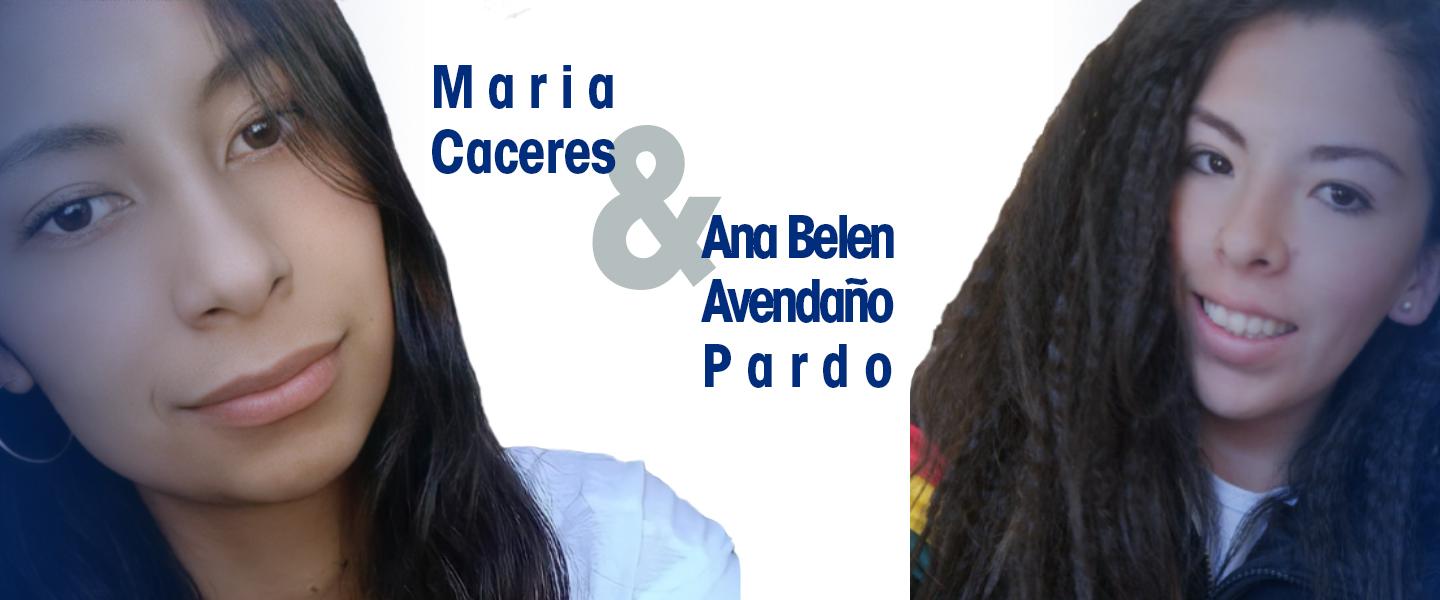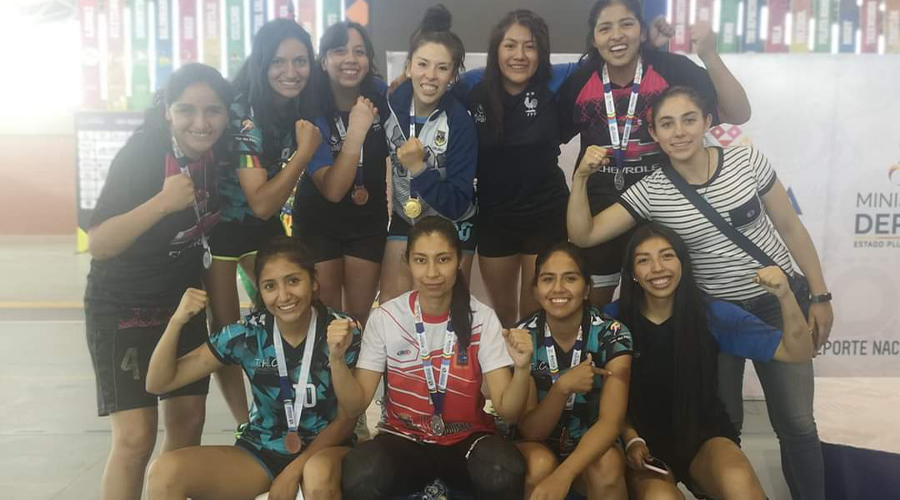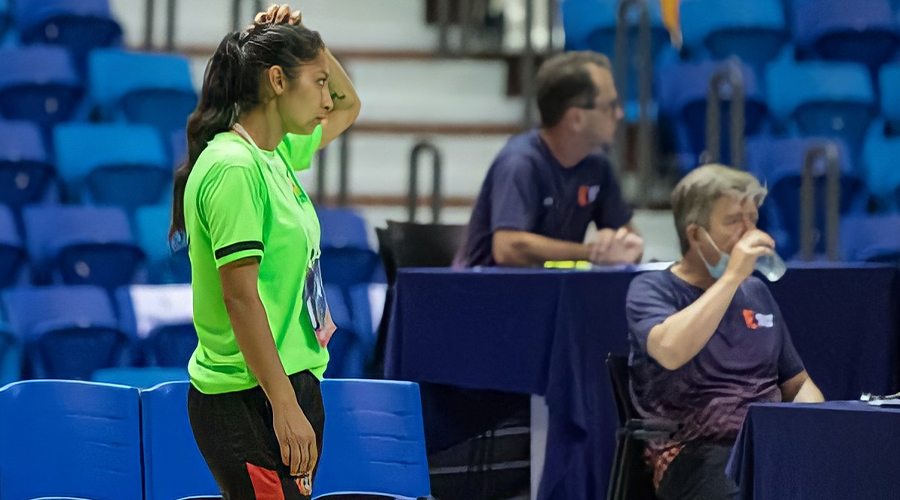Growth, development and overcoming challenges – Bolivia handball on the rise
15 Mar. 2022

Throughout the month of March, the IHF celebrates women in various roles in handball in a special series. Part four focuses on one of the newer IHF member nations – the Bolivian Handball Federation – with Ana Belen Avendaño Pardo and Maria Caceres talking about their own personal handball journeys, the status of handball in the South American country currently and their hopes for the future.
ihf.info: What roles do you have or have had in Bolivian handball? Do you only work in handball?
Ana Belen Avendaño Pardo: I have been part of everything in Bolivian handball. I was a player (club, city selection, national women’s youth, junior and senior team), the first woman to play in another country when I played in Paraguay in 2017, a national referee since 2016, technical delegate, men’s and women’s coach and am currently head of referees.
As a technical delegate, I helped organise the first national senior handball league in Bolivia, but do everything from organising the national events to cleaning sports venues so that our handball continues to grow. I'm also studying to be a teacher.
Maria Caceres: I am currently the treasurer of the federation, but since 2020 I have been more inclined towards the path of coaching. I began to take courses and everything related and earlier this year I had the opportunity to coach the men’s senior team at the South and Central America Handball Confederation Men’s Championship in Recife, Brazil.
Before I started working with the federation last year, I only dedicated myself to playing but as treasurer, I manage all the accounts of the federation and as an executive we try to generate income to support it with player registrations, registrations for national championships and sponsorships.
During the COVID-19 pandemic, as coaches, we had the initiative to carry out virtual training sessions for our younger age groups with three ‘microcycles’: two for the younger age men’s and women’s categories and one for the women’s senior team. We had that desire to improve and to continue growing in knowledge to transmit to the generations that are starting.
I am also a physiotherapist kinesiologist working Monday to Friday in a private practice in my hometown. I’m always very interested in everything that involves sports and try to keep up-to-date with techniques that are being developed.
ihf.info: How did you discover handball? Do you remember the first time you saw the sport or played it? What did you feel?
Ana Belen Avendaño Pardo: I discovered handball in 2014 through some adverts and went to a very small and humble court where I learned. I felt different, it was something I had never heard, seen or practiced. The adrenaline that I felt and the beauty of handball is not found in any other sport, it is very beautiful.
Maria Caceres: In summer 2018, a very close friend invited me to play handball. I had no idea what the sport was like, if the discipline really existed or if they had just invented it.
As I said before, I like everything related to sports, so I went to play that day. The first day, I didn't understand the rules of the game, at least why a foul or a penalty was given but on the second day I liked the intensity and the adrenaline.
A short time later we were selected to go to China to train for three months on a project that the Bolivian Olympic Committee had launched. It was another level, another intensity and with that I ended up falling in love with the sport.

ihf.info: Bolivia is just a baby on the international scene if we look at the year it became a member of the IHF, in 2009. What is the current state of handball in Bolivia?
Ana Belen Avendaño Pardo: Handball in Bolivia continues to grow, even without support from the authorities. Our handball federation President Martin Chilaca plans and organises our federation to be part of the largest number of international events it can be and encourages national events.
We have five active cities which play handball in all the men’s and women’s categories, two cities playing beach handball and in wheelchair handball we don’t have anything yet.
The cities of Oruro and Cochabamba are strong. Bolivian handball was born in Oruro but Cochabamba won the most recent women’s league. We have around 400 players and 15 pairs of referees and the same number of officials.
Maria Caceres: Bolivian handball has grown a lot these past three years with five of our nine departments playing. Every year, the federation launches refereeing, coaching and school handball courses so that the departments that are not yet participating are included and can become interested in the sport.
In August last year, the Bolivia National Handball League was launched, with the participation of four departmental teams: La Paz, Oruro, Chuquisaca and Cochabamba. In 2022, the league is scheduled to start in April, which is very beneficial for everyone because it helps us grow a lot at a competitive level.
There are 12 clubs across the country and this year, there are plans to include one more club from one of the departments. It could be said that the level of play in Oruro is the strongest, as that is where Bolivian handball was born and they started training long before other cities.
Our dream is that we can provide other generations with more competence and knowledge so that they are better prepared and have the opportunity to leave the country (to play).
ihf.info: What challenges did you face in the early days of the Bolivian Handball Federation, how did you overcome them and how do you assess the development of the federation and the sport in your country?
Ana Belen Avendaño Pardo: It was difficult to start and it continues to be because we are very new to handball. The match statistics show how far we still have to go but they also show how much we have grown. Work is underway, but we need more support and new strategies to grow.
Unfortunately, in Bolivia they do not believe in new sports, only in the usual ones like football. There is development at the level of the federation through our president Martin Chilaca. We also believe that the IHF can bet on Bolivia as we are showing a lot of growth.
ihf.info: The second South and Central America Handball Confederation Men’s Championship took place in Brazil in January. Bolivia had just 10 players and could not win against the other nations there. What do you take from the experience?
Maria Caceres: To persist; to remain firm and constant. To compete against teams that have many years of experience actually favours us a lot as that international competition helps to increase Bolivia's level. The game played by international teams is very fluid and it is something that Bolivia lacks, but with each competition, we will grow more.
As we only had 10 players the main thing was to save energy. We made changes to give the players breathing room. I asked them to exploit individualities at key moments and the boys demanded a lot. They showed their improvement on the last day against Costa Rica. In the first half there was not much difference as we took our game against Argentina as a reference.
Our goalkeeper Herbert Rosales (voted best player against Uruguay) is one of the oldest players in Bolivia, but he is just 22. He has been part of the national team since 2017 and has been in constant competition since he was 16 years old. His perseverance bore fruit on the day of the match against Uruguay and for him to be recognised internationally is something desired by all. He has a whole future ahead of him and he knows that he can go further, he trains every day and is simply dedicated to handball.
It was also extremely enriching for me personally as I had the opportunity to talk with Diego Soto, the coach from Costa Rica who taught me a lot and gave me the help I needed to continue the coaching process. Being next to the important people of handball – world players, highly-recognised and respected coaches – was an inexplicable feeling, a unique experience.

It is very important for us to go out and compete internationally because that is the level that helps us grow. They are the players and teams who show us how good or how bad Bolivia is at a sporting level. Not appearing at an international championship is like going backwards in our process and it is the least we want.
ihf.info: How excited are you for the future of Bolivian handball?
Ana Belen Avendaño Pardo: I am very excited and I dream of seeing my country amongst the best in World Championships, Olympic Games and other big events. I believe and trust that there is a very talented future and I am working for that. I am going to be a teacher and I will teach my beloved sport to all the children.
In all this time I can say that the key to everything is diligence. If we are active, they will also be players and so on. Being a new sports discipline in Bolivia, the first thing adults and children want to do is play and they cannot be deprived like I was once, because there are no referees or coaches.
Maria Caceres: Every day we work to make handball grow in Bolivia, and we all do our bit to make that dream come true. We have more people working in each department for the development of Bolivian handball and it is something that was sorely lacking in previous years.
With the league underway now we hope that our sport will continue to grow and more cities will begin to be interested. We will continue launching courses and training to cover more departments (regions).
ihf.info: A few years ago there were some really interesting pictures showing elder Aymara ladies from handball playing the sport in La Paz – do you know anything about this?
Maria Caceres: It was extraordinary news at the time, because nobody knew what it was or what handball was about then. But, of course, it was the work of a pioneering team and the handball directorate at that time, which left that seed so that from there, handball began to develop in our country.
Ana Belen Avendaño Pardo: If those ladies, without knowing what handball is, were already playing it, it is significant for me because in the end, there may be many people in Bolivia playing handball without knowing what it is called or what it is about. It gives us all an even greater light of hope.
ihf.info: Who has supported you on your handball journey?
Ana Belen Avendaño Pardo: My greatest support has been my mother and also, the first coach I had who is now the current president of the Bolivian Handball Federation, Martin Chilaca. Handball has taught me so much. Other sports are nice, but handball is spectacular and when people know it as I know it, I'm sure that many will stay and practice it.
Maria Caceres: The president of the Bolivian Handball Federation, Martin Chilaca, was one of those who supported me the most and helped me, not only me, but all of those who want to see handball grow in our country.
We characterise ourselves by having a very young team on the federation board, but each one collaborates with the growth process of handball in our country, it is a sport that we are passionate about and we are willing to do everything to see Bolivia emerge.
Photos courtesy of Maria Caceres and Ana Belen Avendaño Pardo

